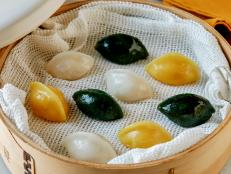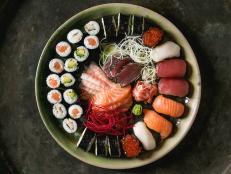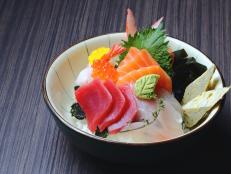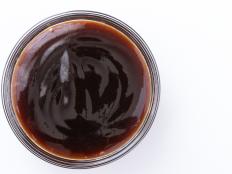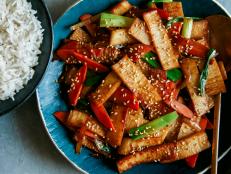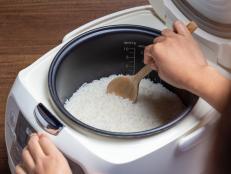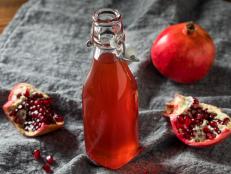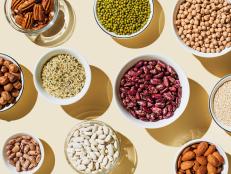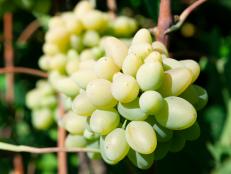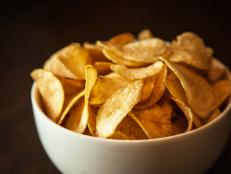Southeast Asian Cooking Glossary
Bahn mi: This Southeast Asian lunch favorite is made with a small baguette, split open lengthwise and filled with pickled carrots and daikon, fresh lettuce, cilantro, chili sauce and Vietnamese bologna, pate and/or grilled lemongrass-flavored sliced pork.
Calamansi: A citrus fruit the size of a key lime, calamansi is often used as a souring ingredient in soups.
Carambola: Green star fruit, sometimes used as a souring ingredient in soups.
Daikon: This Asian radish is used in raw in salads, pickled with cucumber, carrot and rice vinegar, or cooked in stir-fries.
Galangal: This pungent rhizome is used in sour soups, such as the classic Thai spicy and sour shrimp soup, as well as numerous stews and marinades. Fresh galangal resembles fresh ginger in appearance, but has a pungent, citrusy taste.
Goi cuon: Literally meaning "mixed salad roll," goi cuon is the Vietnamese word for summer rolls – the deliciously refreshing rolls of shrimp, lettuce, carrot, cucumber and mint wrapped in softened rice paper.
Hoisin sauce: A thick, sweet and savory condiment, Hoisin sauce is made with fermented soybeans, garlic, chiles and spices. It's often used as a dipping sauce direct from the jar, and it's also a major ingredient in peanut sauce and marinades.
Kaffir lime leaves: These glossy, dark green, fragrant leaves are grown in Southeast Asia, and lend an important, citrusy flavor to many regional curries and soups.
Kecap manis: This sweet soy sauce is used direct from the bottle to dip spring rolls and all sorts of grilled foods, and as a table condiment in Indonesian and Malaysian cuisines.
K'way teao: This rice noodle soup is a popular street food in many parts of Southeast Asia. The soup was once considered breakfast or snack fare, but it is now sold as a one-dish meal all day long. Noodles are cooked in chicken, pork or beef broth, then topped with meat or fish and mung bean sprouts and garnished with fried shallots, garlic oil, fresh herbs or lime juice.
Lemongrass: A fibrous grass, lemongrass has citrus notes without the sourness associated with citrus fruit. It is crushed or sliced and added to infuse stocks, or grated and added to marinades or spice pastes.
Mee krob: This Thai dish's title literally translates into "crispy noodle." Rice vermicelli is deep fried and tossed with sweet and sour stir fry, which usually contains fish, shrimp or pork, vegetables, bean sprouts, lemon or lime juice, green onions, chiles, shredded kaffir lime leaves and garlic.
Nam pla: Popular in Thailand, nam pla is a salty, fermented fish sauce with an extremely pungent odor. It's used as a condiment, sauce and seasoning. The sauce is known as nuoc nam in Vietnam.
Nam prik: A general term for a condiment or sauce used to accompany fish, rice and vegetables. The ingredients used vary from region to region and can include chiles, dried fish, tamarind concentrate, fruit (such as green mango) and nuts.
Ngo gai: Also known as "saw leaf herb" because of its thick, jagged leaves, ngo gai is a variety of coriander widely used throughout Southeast Asia. It is stronger and earthier than cilantro, but cilantro is a fine, readily available substitute.
Nuoc cham: This sweet lime, fish sauce, garlic and chile dipping sauce is a ubiquitous table condiment throughout Vietnam, Cambodia and Laos. It's also used to dip spring rolls, grilled meats and seafoods.
Pad thai: This stir-fry is Thailand's most famous noodle dish. It contains cooked rice noodles, tofu, shrimp, crushed peanuts, nam pla, bean sprouts, garlic, chiles and eggs.
Peanut sauce: This popular dipping sauce is made from dry roasted peanuts, hoisin sauce, fish sauce and coconut milk. There are many regional variations, and the sauce can be enhanced with garlic, shallots, chiles or red curry paste.
Pho: This traditional Vietnamese noodle soup is made of meat and rice stick noodles and flavored with seasonings like star anise, ginger, cilantro and onion. Pho is most commonly made with clear beef broth and served with thin slices of rare beef (bo pho), but variations include chicken, fish, pork or meatballs.
Sambal: A multi-purpose condiment popular in Indonesia and Malaysia. Its most basic form, sambal oelek, is a simple mix of chiles, brown sugar and salt. Another popular blend is sambal badjak, which adds garlic, kaffir lime, onions, trassi galangal, tamarind and coconut milk. Can also include coconut , meat, seafood or veggies.
Sate, satay: Grilled, skewered meat morsels flavored herbs and spices. This Indonesian favorite is a popular snack food sold by street vendors, but it is also served as an appetizer and sometimes as a main dish. Sate is typically served with chili sauce, nuoc cham or a peanut-based dipping sauce.
Sour soups: Sour soups are enjoyed across Southeast Asia, and typically have a clear broth flavored with Thai basil, kaffir lime leaves, galangal and lemongrass. Tom yum goong, which means "hot and sour soup with shrimp," is one of the most popular varieties of sour soup in Thailand.
Sriracha sauce: This Thai hot sauce is named after the seaside town of Si Racha, which is located on the gulf of Thailand. This widely used sun-ripened chile table condiment is used as widely in Southeast Asia as ketchup is in the U.S.
Star anise: Slightly more bitter than regular anise, star anise is a star-shaped, dark brown pod that contains a pea-sized seed in each of its eight segments. In Asian cuisine, it's commonly used as a spice and as a tea flavoring.
Teh tarik: Popular in Malaysia and Singapore, teh tarik is poured back and forth with condensed milk to create a thick froth. It's often compared to cappuccino because of the frothy top.
Thai basil: A dark green leaf with a purple stem, this delicious herb has a licorice note, and is used throughout Southeast Asia. Thai basil's flavor is unique and has little in common with Italian basil, which will not do as a substitute. If you cannot find it, use fresh mint or cilantro for a different yet appropriately Asian flavor.
Thai chiles: These small, thin peppers provide the characteristic spice in many Southeast Asian dishes. Also known as "bird chiles" because drying causes the chile to hook like a bird's beak, they pack a fiery punch that doesn't dissipate with cooking.
Tom khai gai: This soup's name literally translates to "boiled galangal chicken." The spicy sweet Thai soup is made with coconut milk, galangal, lemongrass, kaffir lime leaves, chicken and mushrooms.




























